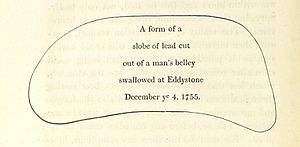Henry Hall (lighthouse keeper) facts for kids
Quick facts for kids
Henry Hall
|
|
|---|---|
| Born | 1661 |
| Died | 8 December 1755 (aged 94) East Stonehouse, Plymouth, England
|
| Cause of death | Internal burns from molten lead |
| Occupation | Lighthouse keeper |
Henry Hall (born 1661, died 1755) was a brave lighthouse keeper from Britain. He worked at the famous Eddystone Lighthouse. This lighthouse was located off the coast of Devon, England.
Who Was Henry Hall?
Henry Hall was born in 1661. He was part of a long line of lighthouse keepers. His family kept lighthouses lit around the English and Welsh coasts for many years. They worked from the 1700s until 1913. The Hall family also connected with other lighthouse families, like the Knotts and the Darlings. A very famous member of the Darling family was Grace Darling. She was known for helping to rescue people from a shipwreck.
The Eddystone Lighthouse Fire
Henry Hall is best remembered for a terrible fire at the Eddystone Lighthouse. This happened on December 2, 1755. The lighthouse at the time was a wooden tower built in 1706.
Around 2:00 AM, Henry Hall was on duty by himself. He saw that a spark from the lamp had set the roof on fire. He quickly tried to put out the flames. He threw buckets of water high above his head. Soon, the other two lighthouse keepers joined him. They all worked hard to fight the fire.
As Henry Hall looked up to check his progress, something terrible happened. Hot, melted lead from the lighthouse roof rained down on him. The lead burned his head, face, neck, and shoulders. Henry Hall even said he swallowed some of the molten lead. Despite his injuries, he kept trying to help his friends. But the three keepers could not stop the fire. They had to go down the tower. They found shelter in a cave to avoid the falling hot debris.
The lighthouse kept burning for five days. Around 10:00 AM, a passing boat saw the three men. The sea was too rough for the boat to get close to the cave. So, the sailors threw a rope to Henry Hall and his friends. The keepers tied the ropes around themselves. Then, they were pulled through the water to the boat.
They were taken to East Stonehouse, Plymouth. There, a surgeon named Dr. Henry Spry treated Henry Hall. Dr. Spry took care of his burns and other injuries. Henry Hall spoke to the doctor in a very hoarse voice. He said he had severe pain inside. Dr. Spry found it hard to believe that someone could swallow molten lead and still be alive hours later. He thought Henry Hall was just confused because of the accident and his old age. Henry Hall was 94 years old at the time. Dr. Spry later wrote that Henry Hall was "of good constitution, and extremely active for one of that age."
Henry Hall's Death
In the days after the fire, Henry Hall was able to eat and drink. He also took medicine. He kept telling Dr. Spry about the lead in his stomach. He told a friend who visited him the same story.
At first, it seemed like Henry Hall was getting better. But by the sixth day, Dr. Spry noticed that Henry Hall's health was getting worse. He could no longer eat or drink. His condition quickly declined. Henry Hall died on Monday, December 8, 1755. He was 94 years old. He passed away at his home in East Stonehouse, Plymouth.
Dr. Spry performed an autopsy on Henry Hall. He found a piece of lead inside him! This proved Henry Hall's story was true. Dr. Spry wrote down how Henry Hall and his friends had explained it: "As he was endeavouring to extinguish the flames... the lead of the lanthorn being melted dropped down... with great force into his mouth then lifted up and open, and in such a quantity, as to cover not only his face, but all his clothes."
Many people, including the The Royal Society in London, were very doubtful. To prove it was possible, Dr. Spry even did experiments. He poured melted lead down the throats of dogs and chickens. This showed that it was possible to survive for a short time after such an extreme accident.
Henry Hall's Legacy
Today, there is a small plaque in Plymouth city centre dedicated to Henry Hall. It tells a few details about how he died. You can find it set into the pavement near Plymouth Pavilions.
The actual piece of lead found in Henry Hall's stomach is now kept safe. You can see it at the National Museum of Scotland.



